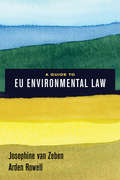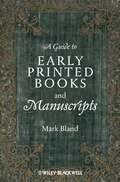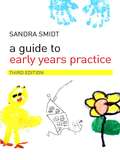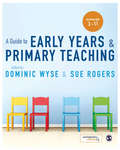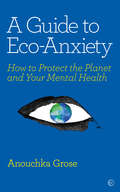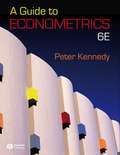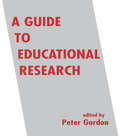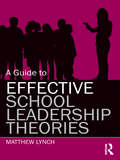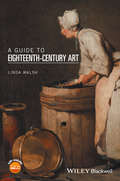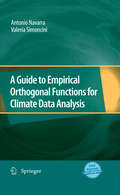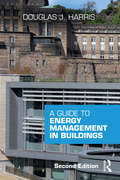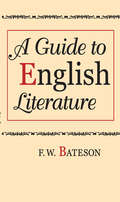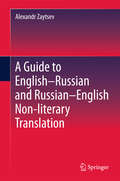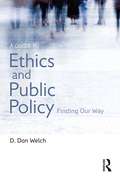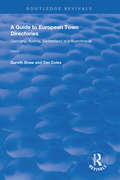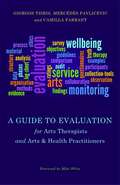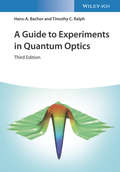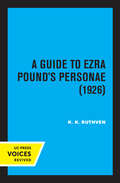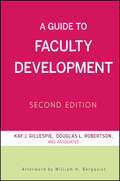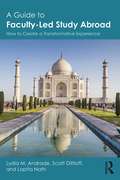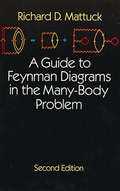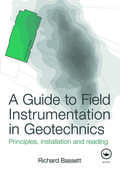- Table View
- List View
A Guide to EU Environmental Law
by Arden Rowell Josephine van ZebenWritten by two internationally respected scholars, this unique primer distills European Union environmental law and policy into a practical guide for a nonlegal audience, as well as for lawyers trained in other jurisdictions. The first part explains the basics of the European legal system, including key actors, types of laws, and regulatory instruments. The second part describes the EU’s overarching legal strategies for environmental management and delves into how the EU addresses the specific environmental issues of pollution, ecosystem management, and climate change. Chapters include summaries of key concepts and discussion questions, as well as informative "spotlights" offering brief overviews of topics. With a highly accessible structure and useful illustrative features, A Guide to EU Environmental Law provides a long-overdue synthetic resource on EU environmental law for students and for anyone working in environmental policy or environmental science.
A Guide to Early College and Dual Enrollment Programs: Designing and Implementing Programs for Student Achievement
by Russ OlwellThis is an accessible guide for school leaders and educators who seek to build, support, and expand effective early college and dual enrollment programs in their communities. One of the first books to bring together research in a practical way, this book is full of real stories, critical insights from leaders, teachers, and students, examples of what works and doesn’t work, and strategies to help students successfully make an important jump in their lives, putting them on track to post-secondary education and a career. Whether you’re starting a program from scratch or want to improve an existing dual enrollment and early college program, this book will provide you with the research base, tools, and resources to understand where you and your students fit into the national landscape, and provide guidance and inspiration on the journey to creating an effective program.
A Guide to Early Printed Books and Manuscripts
by Mark BlandA Guide to Early Printed Books and Manuscripts provides an introduction to the language and concepts employed in bibliographical studies and textual scholarship as they pertain to early modern manuscripts and printed texts Winner, Honourable Mention for Literature, Language and Linguistics, American Publishers Prose Awards, 2010Based almost exclusively on new primary researchExplains the complex process of viewing documents as artefacts, showing readers how to describe documents properly and how to read their physical propertiesDemonstrates how to use the information gleaned as a tool for studying the transmission of literary documentsMakes clear why such matters are important and the purposes to which such information is putFeatures illustrations that are carefully chosen for their unfamiliarity in order to keep the discussion fresh
A Guide to Early Years Practice
by Sandra SmidtThis is a practical, accessible guide to early years practice. The author examines current theories about how children learn best and focuses on how we can support and extend the learning of young children. This fully revised edition discusses Birth to Three Matters, the new Childcare Bill and the development of children's centres, and has additional focus on the Foundation Stage Profile Packed full with case studies, the book offers: practical advice on how to successfully involve parents as equal partners in the education of their children guidance to ensure that the activities and support offered to young children will promote learning across a broad and balanced Early Years curriculum a focus on special needs, multiculturalism and multilingualism, play and culture, and the importance of interactions with adults and with peers. Essential reading for students on Early Years courses, this book is also invaluable for practitioners, who can use this text as the starting point for developing their own methods within the frameworks of statutory documents relating to Early Years education.
A Guide to Early Years and Primary Teaching
by Professor Dominic Wyse Professor Sue RogersHow do people become effective teachers? This is the textbook students need to support them on this journey, no matter their training route or whether primary or early years in focus. Through a unique pairing of academic research and teaching expertise, each chapter is collaboratively authored by an academic specialist and an experienced practitioner to provide a realistic and practical view of teaching children from years 3 - 11. The book combines all the major topics, theories and research students need to know, along with up-to-date policy and legislation. Inventive and practical learning aids and carefully crafted online resources will help readers to: Understand: helpful learning aims at the beginning and summaries at the end of every chapter guide students through each topic Apply: Spotlight on Practice features highlight real teaching examples, Putting it into Practice features provide advice on how key concepts can be employed in real life whilst classroom activities on the website provide further ideas for teaching Reflect on key concepts, as well as your own practice and values, through the refection points and author podcasts on the website outlining key issues to stimulate critical thinking Go further with informative annotated further reading at the end of every chapter, links to relevant websites integrated throughout, and carefully selected SAGE journal articles freely available on the website An essential textbook for use across all your primary and early years teaching courses - whether students are training to be lower/upper primary school teachers or early years practitioners, including those on undergraduate or postgraduate teacher training courses and employment-based routes.
A Guide to Early Years and Primary Teaching
by Professor Dominic Wyse Professor Sue RogersHow do people become effective teachers? This is the textbook students need to support them on this journey, no matter their training route or whether primary or early years in focus. Through a unique pairing of academic research and teaching expertise, each chapter is collaboratively authored by an academic specialist and an experienced practitioner to provide a realistic and practical view of teaching children from years 3 - 11. The book combines all the major topics, theories and research students need to know, along with up-to-date policy and legislation. Inventive and practical learning aids and carefully crafted online resources will help readers to: Understand: helpful learning aims at the beginning and summaries at the end of every chapter guide students through each topic Apply: Spotlight on Practice features highlight real teaching examples, Putting it into Practice features provide advice on how key concepts can be employed in real life whilst classroom activities on the website provide further ideas for teaching Reflect on key concepts, as well as your own practice and values, through the refection points and author podcasts on the website outlining key issues to stimulate critical thinking Go further with informative annotated further reading at the end of every chapter, links to relevant websites integrated throughout, and carefully selected SAGE journal articles freely available on the website This is an essential textbook for use across all your primary and early years teaching courses - whether students are training to be lower/upper primary school teachers or early years practitioners, including those on undergraduate or postgraduate teacher training courses and employment-based routes.
A Guide to Eco-Anxiety: How to Protect the Planet and Your Mental Health
by Anouchka GroseThe first book to tackle the growing phenomenon of eco-anxiety. Written by a psychoanalyst, with a foreword from Caroline Hickman from the Climate Psychology Alliance, this book offers emotional tools and strategies to ease anxiety by taking positive action on a personal and community level.A Guide to Eco-Anxiety outlines a manifesto for action, connection and hope. Showing how to harness anxiety for positive action, as well as effective ways to reduce your personal carbon footprint.The most powerful thing we can do to combat climate change is to talk about it and act collectively. But despite it being an emergency, most people don't bring climate change into conversation in everyday life.The book explores the health impact of experiencing eco-anxiety, grief and trauma, and signposts recommended treatments and therapies. It also tackles practical issues such as: why it's important to reduce plastic waste; parenting and the choice to have a family; which is more effective to bring your carbon footprint down, go vegan or fly less?The book will cultivate a pragmatic form of hope by offering a dynamic toolkit packed with practical ways to connect with community and systemic support, self-care practices to ease the symptoms of anxiety, and strategies to spread awareness and - crucially - bring about change.
A Guide to Econometrics (6th edition)
by Peter KennedyThis book designed to illuminate the logic of econometrics without formulas, providing intuition, skepticism, insights, humor, and practical advice. Designed for use in a range of courses, from undergraduate to graduate and PhD level.
A Guide to Educational Research
by Peter GordonThis account of development in educational research is intended as a guide to possible research areas, both fundamental and policy-related, for students in colleges and higher education institutions, and should also be of interest to those engaged in curriculum planning and administration.
A Guide to Effective School Leadership Theories
by Matthew LynchEducational administrators know that leadership requires hundreds of judgments each day that require a sensitivity and understanding of various leadership strategies. Bridging the gap between the academic and practical world, A Guide to Effective School Leadership Theories provides an exploration of ten dominant leadership strategies to give school leaders a solid basis in theory and practical application. Demonstrating the advantages and drawbacks of each theory, readers are encouraged to discover the most appropriate strategy, or combination of strategies, that will best enable their school to achieve positive results. Each Chapter Includes: Introductory vignettes grounding the leadership theory in practice Discussion of the history, development, and utility of the strategy Research findings for further exploration of the theory End-of-chapter questions and activities designed to connect theory to practice This book is essential reading for aspiring and practicing school leaders who wish to have a better understanding of their leadership role. Providing a focused, up-to-date introduction to the current themes and dimensions of educational leadership, A Guide to Effective School Leadership Theories presents all the tools necessary to analyze and implement effective leadership in readers’ own settings.
A Guide to Eighteenth-Century Art
by Linda WalshA Guide to Eighteenth-Century Art offers an introductory overview of the art, artists, and artistic movements of this exuberant period in European art, and the social, economic, philosophical, and political debates that helped shape them. Covers both artistic developments and critical approaches to the period by leading contemporary scholars Uses an innovative framework to emphasize the roles of tradition, modernity, and hierarchy in the production of artistic works of the period Reveals the practical issues connected with the production, sale, public and private display of art of the period Assesses eighteenth-century art’s contribution to what we now refer to as ‘modernity’ Includes numerous illustrations, and is accompanied by online resources examining art produced outside Europe and its relationship with the West, along with other useful resources
A Guide to Empirical Orthogonal Functions for Climate Data Analysis
by Valeria Simoncini Antonio NavarraClimatology and meteorology have basically been a descriptive science until it became possible to use numerical models, but it is crucial to the success of the strategy that the model must be a good representation of the real climate system of the Earth. Models are required to reproduce not only the mean properties of climate, but also its variability and the strong spatial relations between climate variability in geographically diverse regions. Quantitative techniques were developed to explore the climate variability and its relations between different geographical locations. Methods were borrowed from descriptive statistics, where they were developed to analyze variance of related observations-variable pairs, or to identify unknown relations between variables. A Guide to Empirical Orthogonal Functions for Climate Data Analysis uses a different approach, trying to introduce the reader to a practical application of the methods, including data sets from climate simulations and MATLAB codes for the algorithms. All pictures and examples used in the book may be reproduced by using the data sets and the routines available in the book . Though the main thrust of the book is for climatological examples, the treatment is sufficiently general that the discussion is also useful for students and practitioners in other fields. Supplementary datasets are available via http://extra.springer.com
A Guide to Energy Management in Buildings
by Douglas HarrisThis new edition of A Guide to Energy Management in Buildings begins by asking why we need to control energy use in buildings and proceeds to discuss how the energy consumption of a building can be assessed or estimated through an energy audit. It then details a range of interventions to reduce energy use and outlines methods of assessing the cost-effectiveness of such measures. Topics covered include: where and how energy is used in buildings energy audits measuring and monitoring energy use techniques for reducing energy use in buildings legislative issues. And new in this edition: the cooling of buildings fuel costs and smart metering and education and professional recognition. It provides a template for instigating the energy-management process within an organization, as well as guidance on management issues such as employee motivation, and gives practical details on how to carry the process through. This book should appeal to building and facilities managers and also to students of energy management modules in FE and HE courses.
A Guide to English Literature
by F. W. BatesonAt first glance A Guide to English Literature may seem to be no more than a short bibliography of English literature with perhaps rather more extensive--and certainly more outspoken--comments on the principal editions, commentaries, biographies, and critical works than bibliographies usually provide. But it is something more: this guide contains long ""inter-chapters"" that provide reinterpretations of the principal periods of English literature in the light of modern research, as well as two final sections summarizing in unusual detail the literary criticism that exists in English and recent scholarship in the field. The purpose of this book, then, is to provide the reader with convenient access to a disciplined study of the texts themselves.This guide proposes itself as a new kind of literary history. The conventional history of literature has often tended to become a substitute for the reading of the literature it describes: the better the history, the greater the temptation to substitute it. The present combination of reading lists and inter-chapters cannot be a substitute for anything else. Meaningless as literature in themselves, they nevertheless provide the necessary preliminary information to meaningful reading. Since oddities of arrangement derive from these assumptions, the authors are not arranged alphabetically. Instead there are chronological compartments--with the divisions circa 1500, 1650, and 1800--in which authors succeed each other in the order of their births.This pioneering handbook is primarily a bibliographical laborsaving device. It is meant mostly for students and the general reader in that it stops where original research by the reader is expected to begin. However, the last chapter on literary scholarship is devoted specifically to the research specialist and provides indispensable equipment for the reader. There is also a general section on literary criticism which will be of use to all.
A Guide to English-Russian and Russian-English Non-literary Translation
by Alexandr ZaytsevLying at the intersection of translatology, cognitive science and linguistics, this brief provides a comprehensive framework for studying, investigating and teaching English-Russian/Russian-English non-literary translation. It provides a holistic perspective on the process of non-literary translation, illustrating each of its steps with carefully analyzed real-life examples. Readers will learn how to choose and process multidimensional attention units in original texts by activating different types of knowledge, as well as how to effectively devise target-language matches for them using various translation techniques. It is rounded out with handy and feasible recommendations on the structure and content of an undergraduate course in translation. The abundance of examples makes it suitable not only for use in the classroom, but also for independent study.
A Guide to Essential Human Services (2nd edition)
by Frederic G. ReamerThis book provides useful information on local, state, and government assistance programs and is beneficial to social workers, social work educators, and agencies providing services to individuals which include health care services, addictions, sexual orientation, family life education, children and adolescents, military personnel and veterans, immigrants and refugees, education and literacy, employment assistance, and legal services and dispute resolution, etc.
A Guide to Ethics and Public Policy: Finding Our Way
by D. Don WelchDeveloped by D. Don Welch during his 28 years of teaching ethics and public policy, the rationale behind A Guide to Ethics and Public Policy is to present a comprehensive guide for making policy judgments. Rather than present specific cases that raise moral issues or discuss the role a few concepts play in the moral analysis of policy, this book instead provides a broad framework for the moral evaluation of public policies and policy proposals. This framework is organized around guiding five principles: benefit, effectiveness, fairness, fidelity, and legitimacy. These principles identify the factors that should be taken into account and the issues that should be addressed as citizens address the question of what the United States government should be able to do. Organized by concept, with illustrations and examples frequently interspersed, the book covers both theory and specific issues. A Guide to Ethics and Public Policy outlines a comprehensive ethical framework, provides content to the meaning of the five principles that comprise that framework through the use of illustrations and examples, and offers guidance about how to navigate one’s way through the conflicts and dilemmas that inevitably result from a serious effort to analyze policies.
A Guide to European Town Directories: Volume One - Germany, Austria, Switzerland and Scandinavia. (Routledge Revivals)
by Gareth Shaw Tim ColesFirst published in 1997, European Directories is a major resource guide for urban historians and historical geographers. It provides a detailed bibliography of all directories published and available in major libraries throughout Germany, Austria, Switzerland, Denmark and Scandinavia. In addition, the book provides an account of the evolution of town directories, as well as giving an analysis of directory reliability and coverage. Researchers will also find an extensive bibliography for each country of literature that has utilized directory information in historical studies. The second volume includes France and southern Europe. The whole provides the first European-wide resource for those undertaking urban historical studies.
A Guide to Evaluation for Arts Therapists and Arts & Health Practitioners
by Mike White Mercedes Pavlicevic Camilla Farrant Giorgos TsirisEvaluation is crucial to the development and sustainability of Arts Therapy and Arts & Health practices. This guide supports practitioners in their quest to integrate thorough evaluation procedures in their everyday practices by providing practical guidance for designing, planning and implementing bespoke evaluation projects. Based on the authors' experience of designing and realising evaluation projects and running training workshops, a range of suggestions are offered for developing appropriate timelines and collection tools, ensuring organisational diplomacy, and managing what can be a delicate balance of truth, fact and perception. This guide will help practitioners to evaluate their services and projects by taking into consideration the unique profile of the practice, the workplace, clients, project participants, and sectors.
A Guide to Experiments in Quantum Optics
by Hans-A. Bachor Timothy C. RalphProvides fully updated coverage of new experiments in quantum optics This fully revised and expanded edition of a well-established textbook on experiments on quantum optics covers new concepts, results, procedures, and developments in state-of-the-art experiments. It starts with the basic building blocks and ideas of quantum optics, then moves on to detailed procedures and new techniques for each experiment. Focusing on metrology, communications, and quantum logic, this new edition also places more emphasis on single photon technology and hybrid detection. In addition, it offers end-of-chapter summaries and full problem sets throughout. Beginning with an introduction to the subject, A Guide to Experiments in Quantum Optics, 3rd Edition presents readers with chapters on classical models of light, photons, quantum models of light, as well as basic optical components. It goes on to give readers full coverage of lasers and amplifiers, and examines numerous photodetection techniques being used today. Other chapters examine quantum noise, squeezing experiments, the application of squeezed light, and fundamental tests of quantum mechanics. The book finishes with a section on quantum information before summarizing of the contents and offering an outlook on the future of the field. -Provides all new updates to the field of quantum optics, covering the building blocks, models and concepts, latest results, detailed procedures, and modern experiments -Places emphasis on three major goals: metrology, communications, and quantum logic -Presents fundamental tests of quantum mechanics (Schrodinger Kitten, multimode entanglement, photon systems as quantum emulators), and introduces the density function -Includes new trends and technologies in quantum optics and photodetection, new results in sensing and metrology, and more coverage of quantum gates and logic, cluster states, waveguides for multimodes, discord and other quantum measures, and quantum control -Offers end of chapter summaries and problem sets as new features A Guide to Experiments in Quantum Optics, 3rd Edition is an ideal book for professionals, and graduate and upper level students in physics and engineering science.
A Guide to Ezra Pound's Personae (1926)
by K. K. Ruthven"Both a commentary on and a critical appreciation of the work of the early Pound. It starts off with a luci introduction to Pound's technique in general, and to his imagist phase (during which the poems commented on in this book were written) in particular. In the critical passages Mr. Ruthven steers a sage middle course between the attitudes of uncritical adoration and wholesale rejection that mar so much of the literature on Pound. . . . informative without being pedantic, and exhaustive without being long-winded. . . .To turn to Mr. Ruthven's Guide is to follow in the footsteps of an intelligent, sensitive and reliable scholar." --English Studies This title is part of UC Press's Voices Revived program, which commemorates University of California Press's mission to seek out and cultivate the brightest minds and give them voice, reach, and impact. Drawing on a backlist dating to 1893, Voices Revived makes high-quality, peer-reviewed scholarship accessible once again using print-on-demand technology. This title was originally published in 1969.
A Guide to Faculty Development
by Kay William H. Bergquist Gillespie 160 J. Robertson Douglas L.Since the first edition was published, the dynamics of higher education and faculty development have greatly changed. A Guide to Faculty Development provides an introduction and a guide to faculty development as well as new topics like working with adjuncts, diversity, multiculturalism, assessment, and different issues associated with the various types of campuses. Sponsored by The Professional and Organizational Development Network in Higher Education, this revised and updated guide is essential for faculty developers and administrators newly involved as well as experienced in faculty development.
A Guide to Faculty-Led Study Abroad: How to Create a Transformative Experience
by Scott Dittloff Lydia M. Andrade Lopita NathA Guide to Faculty-Led Study Abroad provides practical information on the curricular and administrative considerations necessary to design and implement a course-based study abroad experience of the highest quality. From techniques for funding the trip, to legal considerations, curricular development, and cultural preparation, this book explains how to create a meaningful and valuable international experience in a variety of settings and formats. The study abroad novice and experienced faculty or administrator alike will benefit from this step-by-step guide on how to create a truly transformative, course-based study abroad experience.
A Guide to Feynman Diagrams in the Many-Body Problem: Second Edition
by Richard D. Mattuck"A great delight to read." -- Physics TodayAmong the most fertile areas of modern physics, many-body theory has produced a wealth of fundamental results in all areas of the discipline. Unfortunately the subject is notoriously difficult and, until the publication of this book, most treatments of the topic were inaccessible to the average experimenter or non-specialist theoretician.The present work, by contrast, is well within the grasp of the nonexpert. It is intended primarily as a "self-study" book that introduces one aspect of many-body theory, i.e. the method of Feynman diagrams. The book also lends itself to use as a reference in courses on solid state and nuclear physics which make some use of the many-body techniques. And, finally, it can be used as a supplementary reference in a many-body course.Chapters 1 through 6 provide an introduction to the major concepts of the field, among them Feynman diagrams, quasi-particles and vacuum amplitudes. Chapters 7 through 16 give basic coverage to topics ranging from Dyson's equation and the ladder approximation to Fermi systems at finite temperature and superconductivity. Appendixes summarize the Dirac formalism and include a rigorous derivation of the rules for diagrams. Problems are provided at the end of each chapter and solutions are given at the back of the book.For this second edition, Dr. Mattuck, formerly of the H. C. Orsted Institute and the University of Copenhagen, added to many chapters a new section showing in mathematical detail how typical many-body calculations with Feynman diagrams are carried out. In addition, new exercises were included, some of which gave the reader the opportunity to carry out simpler many-body calculations himself. new chapter on the quantum field theory of phase transitions rounds out this unusually clear, helpful and informative guide to the physics of the many-body problem.
A Guide to Field Instrumentation in Geotechnics: Principles, Installation and Reading
by Richard BassettGeotechnical instrumentation is used for installation, monitoring and assessment on any sizeable project, particularly in urban areas, and is used for recording, controlled remedial work, and safety. This unique and up-to-date book deals with the conceptual philosophy behind the use of instruments, and then systematically covers their practical use
